Unit - 1
Origin and Classification
Q1) Explain the Textural classification system?
A1)
- Texture refers to the visual appearance of the material. It depends upon particle size, shape of the particles and their gradation.
- However, the Textural Classification System is the soil classification of composite soils based exclusively on Particle Size Distribution.
- The most popular and acceptable Textural Classification System is the triangular classification system suggested by U.S. Bureau of Public Roads.
- According to this, particles are classified as sand (0.05-2mm), silt (0.005-0.05mm) and clay (< 0.005mm). The percentage of sand, silt and clay are plotted along the 3 sides of an equilateral triangle, which is further divided into 10 zones, each indicating a type of soil.
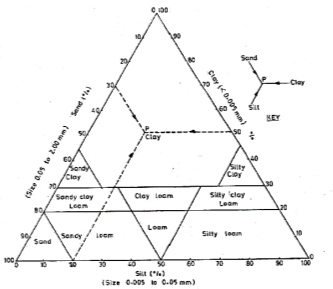
- For example, the point ‘P’ in the figure denotes a soil that contains 30% sand, 20% silt and 50% clay. Hence, this soil is classified as clay.
Q2) Explain AASHTO Soil classification system?
A2)
- American Association of State Highway and Transportation Official (AASHTO) Classification System classifies soil for use on highways, based on particle size distribution and plasticity characteristics.
- Both coarse-grained and fine-grained soil is classified into 8 groups: A1 to A7 with an additional group A8 for peat or muck. A1 and A7 are further sub-divided into 2 categories, while A2 is sub-divided into 4 categories.
- In general, the lower is the group number the more suitable is soil for highway construction.
- Soils within each group are evaluated according to a Group Index (GI) calculated as follows:
GI = 0.2a + 0.005ac + 0.01bd
Where, a = % passing through 75µ sieve greater than 35 but not exceeding 75 as a whole number (0 to 40)
b = % passing through 75µ sieve greater than 15 but not exceeding 55 as a whole number (0 to 40)
c = that portion of numerical liquid limit greater than 40 but not exceeding 60 as a whole number (0 to 20)
d = that portion of numerical plasticity index greater than 10 but not exceeding 30 as a whole number (0 to 20)
- Greater the value of GI, the less desirable is soil for highway construction within that sub-group.
- If GI < 0, it is reported as 0.
- If GI = 0-2: good sub-grade material
- If GI ≥ 2: poor sub-grade material
Q3) Explain how Soil formation takes place?
A3)
- Soils are formed by weathering of rocks due to mechanical disintegration or chemical decomposition.
- Soils are obtained from the geologic cycle that occurs in nature consisting of erosion, transportation, deposition and upheaval of soil from one place to another, by different agents such as wind, water, air etc.

- There are two main groups of soil according to their origin:
Soil formed by physical weathering – gravel and sand
Physical processes include temperature changes, wedging action of ice, spreading of roots of plants and abrasion by different agents.
Soil formed by chemical weathering – silt and clay
Chemical processes include hydration, carbonation, oxidation and hydrolysis.
- If the products of rock weathering are still located at their place of origin, they are called residual or sedentary soils.
- Any soil that has been transported from its place of origin by wind, water, ice or any other agents and has been re-deposited at another location is known as transported soil.
Q4) Explain the types of transported soil?
A4)
- Transported soils are further classified according to the transporting agency like wind, water, ice etc. and method of deposition.
- Alluvial soils: When the all type of soils is carried and deposited by water, then it is termed as alluvial soils.
- Aeolian soils: When the soil get deposited by wind, then it is termed as an Aeolian soil.
- Lacustrine soils: When soil particles caried by flowing water and deposited in lake, then such soils is termed as lacustrine soils.
- Glacial soils: Glacial soil is also termed as drift and drift is a general term used for the deposits made by glaciers. Soils which is mixed with the ice and are transported far away from their original position. Glaciers carry with them sous ranging from the fine grained to huge boulders.
- Peat: A fibrous aggregate of finer fragments of decayed vegetable matter is called as peat. It is very compressible and should be careful while using for supporting foundation of the structure.
- Bentonite: When the clay consists of a very high percentage of clay mineral montmorillonite, then it is called as bentonite. It is a highly plastic soil, and highly water absorbent and high shrinkage and swelling characteristics. Bentonite is a chemically weathered volcanic ash.
- Humus: A dark brown, organic amorphous earth of the top soil is termed as humus. It consist of partly decomposed vegetable matter and not suitable for engineering works
- Glacial soils: Glacial soil is also termed as drift and drift is a general term used for the deposits made by glaciers. Soils which is mixed with the ice and are transported far away from their original position. Glaciers carry with them soils ranging from the fine grained to huge boulders.
- Loess: When the size of soil particles range between 0.01 -0.05 mm, and air borne deposit characterized by a very uniform grain size and high void ratio, then it is called as loess. Its colour is yellowish light brown.
- Inorganic soils: When the soils formed by the accumulation of fragments of the inorganic skeleton or shells of organism, then it is called as inorganic soils.
- Colluvial soils: When the soils transported and deposited by gravity, then it is called as colluvial.
- Organic soils: When the soil formed by growth and subsequent decay of vegetable matter, then it is called as organic soils.
- Gumbo: It is sticky, plastic and dark-coloured clay.
Q5) What are the soil deposits?
A5)
Marin deposits
- Usually along the coast in narrow tidal plains marine clays are found. Marine clay may contain organic matter and also very soft clay.
- Marine clay has low shear strength and high compressibility.
- Because of above properties, such clay has problems to be used as construction material or as a foundation material.
Black cotton soil
- Black cotton soils are usually found in Maharashtra, Madhya Pradesh, Karnataka, Andhra Pradesh, Tamil Nada and Uttar Pradesh.
- Black cotton soil (Indian name) is also known as Expansive soils.
- In India they cover an area of approximately 3,00,500 SQ) Km. These soil is formed from basalt or trap.
- Black cotton soil is characterized by swelling and shrinkage because it contains clay mineral montmorillonite.
- As the volume of black cotton soil changes it is most susceptible to damage the light loaded structure.
- Under-reamed piles are considered most suitable as foundations for houses and other light structures constructed on such soil.
- These piles are taken to depths below the zone of seasonal variation in moisture content.
Laterites and lateritic soil
- This soils are usually found in Kerala, Karnataka, Maharashtra, Orissa and west Bengal.
- In India they cover an area of about 100,000 SQ) Km.
- The decomposition of rock, removal of the bases and silica and formation of oxides of iron and aluminium at the top of the soil profile are responsible for formation of laterites.
- Like all residual soils, laterites show variability in their properties, depending upon the stage of weathering.
Alluvial deposits
- Alluvial soils are formed in large parts of Northern India lying North of vindhyasatpura range in the Indo-Gangetic and Brahmaputra flood plains.
- The alluvial deposits extend from Assam in the East to Punjab in the west.
- The deposits have alternating layers of sand, silt and clay.
Desert soils
- Such soils are found in large parts of Rajasthan.
- They cover an area of about 500,000 sq. m.
- They are formed under highly arid conditions.
- Dune sand is a non-plastic uniformly graded, fine sand.
- Some of the problems associated with this soil are stabilization, settlement perviousness etc.
Boulder deposits
- Boulder deposits are found in the sub-Himalayan regions of Himachal Pradesh and Uttar Pradesh.
- River flowing in hilly terrains and near foot hills are responsible to deposit large quantities of boulders.
- The properties of these deposits depends on the relative proportions of the boulders and the soil matrix.
- This deposits have higher angles of shearing resistance.
Q6) Define Water content, Void ratio, Porosity, Degree of saturation, Air Content & Percentage Air Voids, Unit weight, Specific Gravity & Apparent/ Mass Specific Gravity?
A6)
- Water Content
w =  100
100
w ≥ 0 always
w = water content (%)
Ww = weight of water
Ws = weight of solids
2. Void Ratio
e = 
e > 0 always
e = void ratio
Vv = volume of voids
Vs = volume of solids
Void ratio of fine grained soils > Void ratio of coarse grained soils
3. Porosity
n =  100
100
0 < n < 100 always
n = porosity (%)
Vv = volume of voids
V = total volume of soil
4. Degree of Saturation
S =  100
100
0 ≤ S ≤ 100 always (S=0 for perfectly dry soil and S=100 for fully saturated soil)
S = degree of saturation (%)
Vw = volume of water
Vv = volume of voids
5. Air Content & Percentage Air Voids
ac =  100 = 1 - S
100 = 1 - S
0 ≤ ac ≤ 100
ac = air content (%)
Va = volume of air
Vv = volume of voids
na =  100
100
na = air voids (%)
Va = volume of air
V = total volume of soil mass
6. Unit Weight
a) Bulk Unit Weight: total weight per unit volume
Ƴ = 
Ƴ = bulk unit weight
W = total weight of soil mass = Wa + Ww
V = total volume of soil mass = Va + Vw + Vs
b) Dry Unit Weight: weight of soil solids per unit volume
Ƴd = 
Ƴd = bulk unit weight
Ws = total weight of soil solids
V = total volume of soil mass = Va + Vw + Vs
c) Saturated Unit Weight: weight of fully saturated soil sample per unit volume
Ƴsat = 
Ƴsat = saturated unit weight
Wsat = total weight of saturated soil mass
V = total volume of soil mass = Va + Vw + Vs
d) Submerged Unit Weight: weight of fully saturated soil sample per unit volume
Ƴsub = 
Ƴsub = submerged unit weight of solids = Ƴsat – Ƴwater ≈ Ƴsat/2
Wsat = total weight of saturated soil mass
V = total volume of soil mass = Va + Vw + Vs
7. Specific Gravity & Apparent/ Mass Specific Gravity
Specific gravity of soil solids (G) is the ratio of the unit weight of a given volume of solids to the unit weight of an equivalent volume of water at 4ᵒC.
G = 
Furthermore, apparent specific gravity (Gm) is the ratio of total weight of a given mass of soil to the weight of an equivalent volume of water.
Gm = 
Q7) What is the weight volume relationships?
A7)
- The soil mass in general is a three-phase system composed of soil, liquid and gaseous matter. The solid phase comprises of mineral, organic matter or both.
- The mineral portion consists of particles of different size and shapes.
- The organic fraction is the plant and animal residue which may be present in various stages of decomposition.
- The solids enclose the open spaces termed as voids. The liquid phase is generally water and fills partly or wholly the voids.
- The gaseous phase, usually air, occupies the voids not filled by water. The relative volume wise and weight wise proportions of the three phases in a soil mass are important factors influencing its physical properties.
- It is therefore necessary to study them. Though the three phases precut cannot be separated as shown in below Fig. For better understanding they are shown as occupying separate spaces.
- The diagrammatic representation of the different phase present in a soil mass is called the phase diagram.
- Fig. Shows a three-phase system of natural soil which is partially saturated soil.
- When it is fully saturated i.e., all the voids are filled with water and thus gaseous phase is absent and the soil becomes a two-phase system in fig.
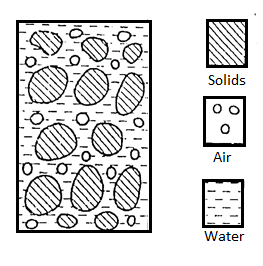
Fig.: Natural soil
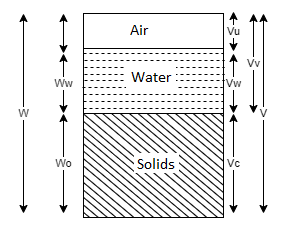
Fig.: Partially saturated soil
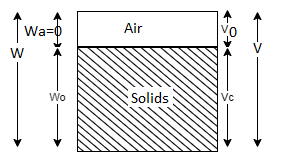
Fig.: Dry condition
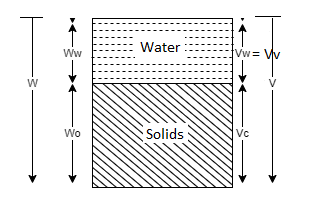
Fig.: Saturated condition
- Also, if the soil becomes totally dry and consists of only solid and gaseous phases. In this case also it is a two-phase system.
Ww=Weight of water
Ws =weight of soils
V =total volume of soil mass
Va =volume of air
Vw =volume of water
Vv =volume of voids
Vs =volume of solids
- For Partially Saturated Condition,
Total weight, W=Ws+Ww+Wa
Wa=0
∴W=Ws+Ww
Total volume, V= Vs+Vv= Vs+Va+Vw (3 phase system)
- For dry condition,
W=Ws
V=Vs+Va (2 phase)
- For fully saturated soil,
W=Ws+Ww
V=Vs+Vw (2 phase)
Q8) What are the types of clay minerals?
A8)
There are 3 most important corporations of clay minerals:
- Kaolinite - additionally consists of dickite and nacrite; fashioned through the decomposition of orthoclase feldspar (e.g. In granite); kaolin is the important constituent in china clay.
- Illite - additionally consists of glauconite (an inexperienced clay sand) and are the commonest clay minerals; fashioned through the decomposition of a few micas and feldspars; main in marine clays and shales.
- Montmorillonites - additionally consists of bentonite and vermiculite; fashioned through the alteration of mafic igneous rocks wealthy in Ca and Mg; weak linkage through cations (e.g. Na+, Ca++) outcomes in excessive swelling/shrinking potential.
Q9) Explain the types of soil structure?
A9)
- The following types of soil structure are generally recognized
- Single grained structure
- Honeycomb structure
- Flocculent structure
- Dispersed structure
- Composite structure
1. Single grained structure:
- When each panicle of soil scales out of suspension separately and independently then such soil structure is known as single grained structure.
- The gravitational forces acting on the particles of soil cases the settlement.
- The specific surface of all particles is comparatively less, thus the surface forces are too small to be considered.
- These surface forces are neglected for all practical purpose in case of course grained soils (Diameter> 0.02 m).
- Such soil particle has high void ratio when the deposits in a loose state and low void ration in a dense state.

Fig.: Single grained structure
2. Honeycomb structure:
- Honeycomb structure is seen in the soil particles having diameter between 0.0002-0.02 mm, usually observed in silts.
- In case of such soils, both gravitational forces and surface forces plays an important role.
- The soil particles settle due to gravitational forces and the surface forces at the contact area, are large enough compared to the submerged weighs to prevent the grains from rolling down immediately.
- The grains which are in contact are blend together until miniature arches are formed, with relatively large void space which is formed as honeycomb structure.
- In such type of structure comparatively large amount of water is enclosed within voids.
- Such type of structure has high voids ratio.
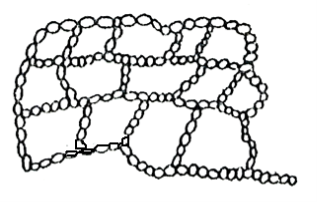
Fig.: Honeycomb structure
3. Flocculent structure:
- Flocculent structure is formed when there is an edge contact between the clay platelets.
- The attractive electrical forces between adjacent soil particles at the time of deposition, is the basic reason for the formation of such type of structure.
- As the concentration of dissolved minerals is the water increases, the tendency of flocculation also increases.
- Flocculent structures are usually observed in clays with fine particles.
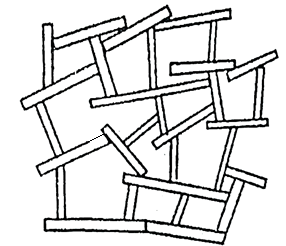
Fig.: Flocculent structure
4. Dispersed structure:
- Dispersed structure is also seen in clays with fine particles.
- The repulsion electrical forces between adjacent soil particles at the time of deposition are responsible to form dispersed structure.
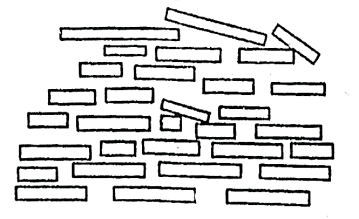
Fig.: Dispersed structure
5. Composite Soil Structure:
- In case of composite soil following two structures can be found,
- Coarse grain skeleton
- Cohesive matrix
1.Coarse grain skeleton:
- When the void space between the single particles is filled with the clay particles; it is called as coarse grain skeleton.
- The bulky particles form a continuous relatively incompressible frame-work.
2.Cohesive matrix:
- When the clay content is more as compared with coarse particles; cohesive matrix is formed.
- Such type of soil formation is relatively more compressible.
Q10) What is Sensitivity?
A10)
- The ratio of unconfined compressive strength of an undisturbed sample of soil to unconfined compressive strength of the remoulded sample of same soil at the same water content as in undisturbed soil is called as sensitivity (St)
St =
Where, qu=unconfined compressive strength of an undisturbed sample of soil or clay
qu’ = unconfined compressive strength of remoulded sample of soil or clay at the same water content as in the undisturbed soil.
- Sensitivity is a measure of the loss in strength of soils and remoulding on the consistency of a cohesive soil.
- Following table shows natural clay deposits classified into four different categories based on the value of sensitivity.
Sr.no | Sensitivity | Classification |
1 | 1-14 | Normal |
2 | 4-8 | Sensitive |
3 | 8-16 | Very sensitive |
4 | 16-32 | Slightly quick |
5 | 32-64 | Medium quick |
6 | Greater than 64 | Quick |
7 | Less than 1 | Stiff clay |
Table: Sensitivity classification soils
Q11) Explain Thixotropy?
A11)
- Thixotropy is a Greek word in which thix means touch and tropo means change, overall meaning of thixtropy is any change which occurs by touch.
- Thixotropy is the property of certain clays or soil by virtue of it gradually regains its lost strength with time if remoulded clay is allowed to rest without change in water content.
- In short, if a remoulded soil sample having the sensitivity more than one is allowed to stand without change in water content and disturbance, then it may regain some parts of its original strength and stiffness. This increase in strength of soil sample is termed as thixotropy.
- Thixotropy has more practical importance in geotechnical engineering. In pile-driving operations, thixotropy plays important role. For example, there is a strength loss of soil, when a pile is driron into the ground in such case, one can easily know regaining of shear strength after the pile has been driven and left in place for some time with the help of thixotropy.
Q12) Explain Unified and Indian Standard soil classification system?
A12)
- The unified classification is based on the airfield classification system that was developed by A. Casagrande
- The system is based on both grain size and plasticity properties of the soil and is therefore, applicable to any use.
- The Indian Standard Institution (now Bureau of Indian Standard) adopted the unified classified system in 1954. The soil classification system 15 1498: 1970 is generally except for mine modification. Hence the salient features of Indian standards on the classification of soils are described below:
Table: Suffixes and prefixes
Soil type | Prefix | Subgroup | Suffix |
Gravel | G | Well graded | W |
Sand | S | Poorly graded | P |
Silt | M | Silty | M |
Clay | C | Clayey | C |
Organic | O | WL<35% | L |
|
| 35<WL<50 | I |
Peat | Pt | 50<WL | H |
Q13) The Void ratio and Specific gravity of sample of clay are 0.73 and 2.7 respectively. If the voids are 92% saturated find the bulk density, dry density and the water content?
A13)
Given:
e =0.73
G=2.7
S=92%
Find:
1)Water content(W)
W=
∴W =24.87%
2)Bulk density( and dry density(
and dry density(



∴
Q14) A Soil sample in its natural state has, when fully saturated, a water content of 32.5%. Determine the void ratio, dry density and saturated unit weights. Assume G=2.69.
A14)
Given:
w =32.5%
G=2.69
Find: Void ratio(e), Dry unit weights( (
( )
)
We know,

For fully saturated S=1
e =w.G=
∴e =0.874
Dry unit weight 

For fully saturated soil S=1
∴e=



Q15) A saturated clay has a water content of 40% and bulk specific gravity is 1.84. Determine the void ratio, and specific gravity of particles.
A15)
Given:
G=1.84
w=40%
e=
e=0.736
We know, n=
n=
n=0.424


∴G=0.78
Q16) A saturated soil sample weighting 1.78 gm has a volume of 96cc.If G=2.67 determine the void ratio, water content and unit weight of the soil?
A16)
Given:
W=178gm
V=96cc
G=2.67
Find: e=?,

18.19=

1+e=1.45
∴e= 1.45-1 =0.45
Q17) The grading curve of a soil gives the effective size as 0.16mm, Find Cu and Cc. Classify the soil.
Find Cu and Cc. Classify the soil.
A17)


Does not meet the requirement of well graded sand, given soil is poorly graded sand.